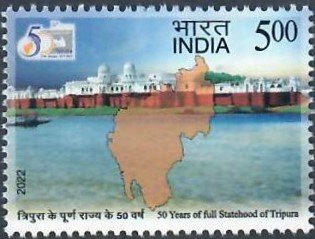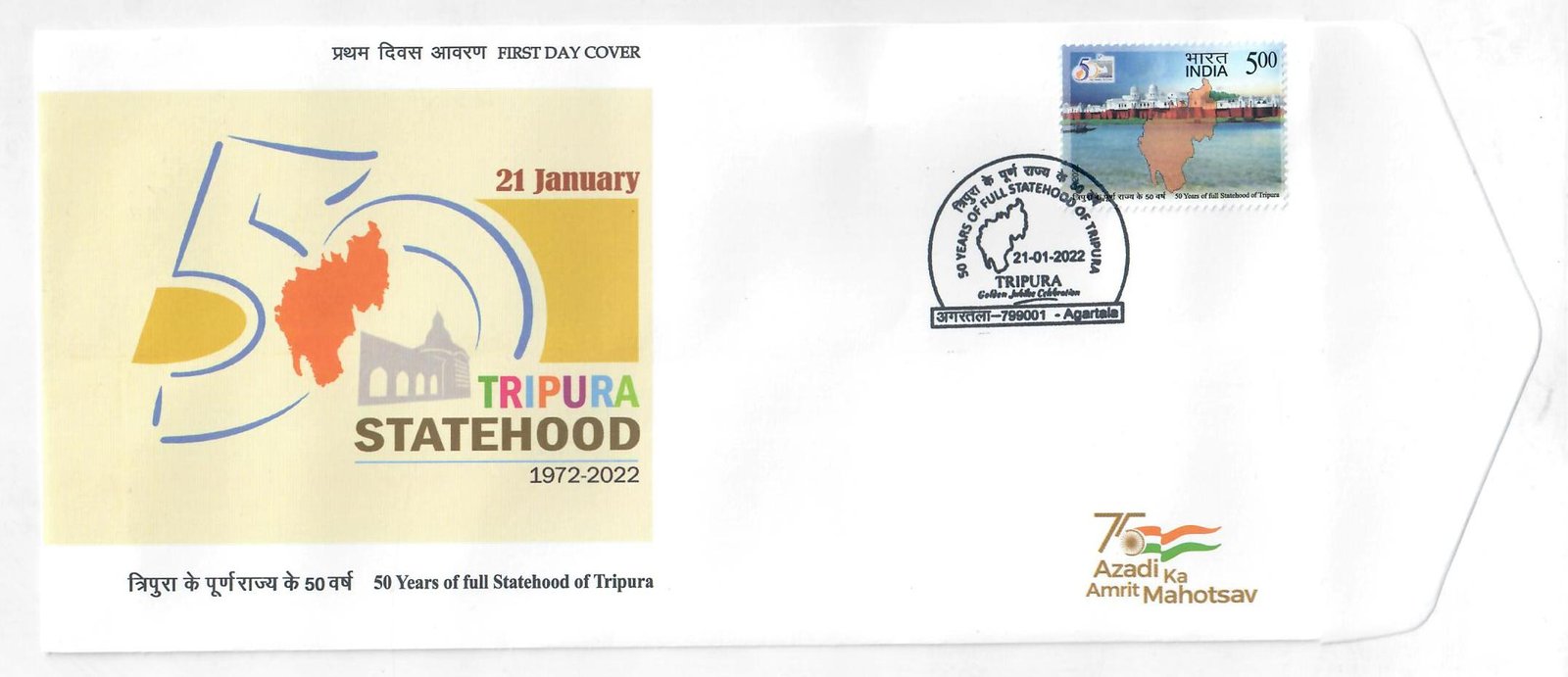Tripura State

Technical Data
| Stamp Set | 50th Anniveresary of Statehoods |
|---|---|
| Date of Issue | January 21, 2022 |
| Denomination | Rs. 5 |
| Quantity | 305,100 |
| Perforation | 13½ x 14 |
| Printer | Security Printing Press, Hyderabad |
| Printing Process | Wet Offset |
| Watermark | No Watermark |
| Colors | Multicolor |
| Credit (Designed By) | Mr. Suresh Kumar Ms. Nenu Gupta |
| Catalog Codes |
Michel IN 3761 Yvert et Tellier IN 3440 Stanley Gibbons IN 3802 |
| Themes | Anniversaries and Jubilees | Maps | Townscapes/ City Views |
Commemorative Postage Stamp Celebrating 50 Years of Tripura’s Statehood
The Jewel of Northeast India
Tripura, a beautiful state in Northeast India, shares its borders with Bangladesh, Mizoram, and Assam. With Bangladesh surrounding it on three sides—north, south, and west—the state has an international border of 856 km, accounting for nearly 84% of its total boundary. The state is connected to the rest of India through NH-44, which links Tripura to Assam, Meghalaya, North Bengal, Kolkata, and beyond.
A Royal Legacy and Cultural Heritage
Tripura has a glorious royal history and has made remarkable contributions to art, culture, science, and intellect. The reign of Maharaja Birchandra Manikya Bahadur marked the beginning of its modern era. It was during this time that Nobel Laureate Rabindranath Tagore developed a special bond with Tripura, enriching its cultural ties.
The state also played a role in the Indian freedom movement, reflecting its patriotic spirit and commitment to the nation.
The Merger with India
The last king of princely Tripura, Maharaja Bir Bikram Kishore Manikya, foresaw India’s independence and initiated Tripura’s integration into the Indian Union. Even before his death in May 1947, he decided to merge with India for the welfare of his people.
After his passing, Queen Kanchanprabha Devi, acting as Regent, signed the Merger Agreement on September 9, 1949, in Delhi on behalf of her minor son, Kirit Bikram Kishore Manikya. Tripura officially became part of India on October 15, 1949, marking the end of royal rule and the beginning of democratization.
From Union Territory to Statehood
- 1950 – Tripura became a “C” category state under a Chief Commissioner.
- 1956 – Elevated to a Union Territory.
- 1957–1962 – Territorial Council elections shaped its democratic framework.
- 1963 – Establishment of the first Legislative Assembly.
- 1972 – Tripura attained full statehood on January 21, 1972, under the Northeast Reorganization Act of 1971.
This transformation empowered Tripura to shape its governance and destiny as part of the Indian Union.
The Cultural Heartbeat of Tripura
Tripura’s charm lies not only in its scenic beauty but also in its rich cultural traditions. The vibrant folk culture of tribal and non-tribal communities forms the backbone of its heritage. Major dance forms such as Hoza Giri, Garia, and Dhamali reflect the artistic brilliance of the state.
Celebrating 50 Years of Statehood through Philately
To honor this historic journey, the Department of Posts released a Commemorative Postage Stamp celebrating 50 years of Tripura’s full statehood.
This special issue pays tribute to:
- Tripura’s royal legacy and democratic progress.
- Its unique cultural traditions and folk dances.
- The resilience and aspirations of its people.
The Tripura 50 Years Statehood Stamp is more than a collector’s item it is a lasting reminder of the state’s transformation from a princely kingdom to a vibrant part of the Indian Union, while preserving its cultural identity and traditions.
First Day Cover

